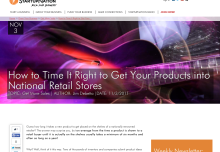Five Things To Know Before You Approach Convenience Store Wholesalers
There’s a convenience store within a short distance just about everywhere you go in the country. They stock everything from candy bars and other snacks to beverages and novelty items. If you’ve got a great idea for a convenience store product, getting it into the hands of the right people is imperative. In order to fully capitalize on the market, selling your product through a convenience store wholesalers may be your best bet. Here are five things every manufacturer should know about getting their products into convenience stores across the country.
- It’s A Huge Market – There are no shortage of convenience stores looking for good products to offer their customers and the number is increasing. In fact, the Association For Convenience & Fuel Retailing says: “The U.S. convenience store count increased to a record 151,282 stores as of December 31, 2013, a 1.4% increase (2,062 stores) from the year prior, according to the 2013 NACS/Nielsen Convenience Industry Store Count.” What’s more, the average convenience store serves around 1,100 customers per day.
- New Is Always Good – If you’ve got a new product that hasn’t been seen before, chances are, it will be well-received. Convenience store owners love to have the latest, greatest products on offer to their customers. Many times, the newest version of beverages and other convenience items are found on the shelves of these stores before they make it into supermarkets and other larger retailers.
- Fast Time To Market – Convenience stores are known for fast service, with the average time spent being a mere 3-4 minutes from entry to checkout. It is also one of the easiest ways to get your product to market when compared to other avenues. Since many convenience stores are individually owned, the process goes faster than selling to a national supermarket chain.
- Your Sales Pitch Matters – No matter how big the store is, you’ve got to convince them that your product is worth their time and space. Determine who is in charge of purchasing and discuss your product with them in person. Bring samples and testimonials from others who have tried it and make sure you’ve got a good price-point set. Remember that the average profit margin is somewhere between 30-50% for convenience store items.
- Convenience Store Distributors – Even if you’ve gotten in touch with the retail buyer, getting your products into stores can be more effective with the right partners. A convenience store distributor that has solid relationships can help you avoid some of the resistance you may encounter. That said, you may still have to contact the buyers to convince them that your product is worth offering.
You’ve spent a lot of time developing your new product and getting it on the shelves for consumers to buy is the next step. A good place to start is by purchasing a convenience store directory that contains the contact information for owners and buyers. If you have any questions about the process, or you’d like some sound advice, contact us, we are always happy to assist entrepreneurs like yourself.




